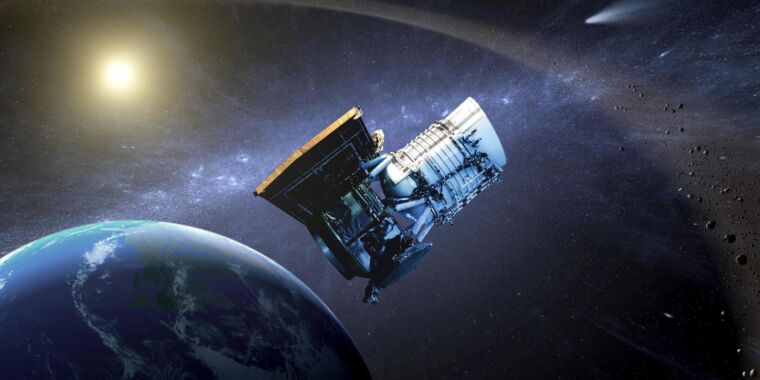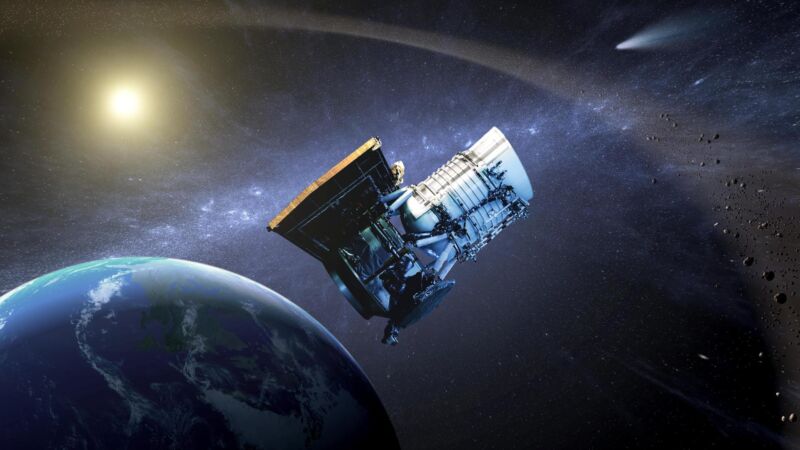

Last week, NASA decommissioned a nearly 15-year-old spacecraft that had discovered 400 near-Earth asteroids and comets, closing an important chapter in the agency’s planetary defense program.
From its position in low Earth orbit, the spacecraft’s infrared telescope scanned the entire sky 23 times and took millions of images, initially searching for infrared emissions from galaxies, stars and asteroids before focusing solely on objects within the solar system.
Preparing for NEOs
In December 2009, the Wide-field Infrared Survey Explorer, or WISE, launched on a mission originally designed to last seven months. After WISE completed its checks and completed its primary astronomical survey of the entire sky, NASA put the spacecraft into hibernation in 2011 after its supply of frozen hydrogen coolant ran out, reducing the sensitivity of its infrared detectors. But astronomers found that the telescope was still capable of detecting objects closer to Earth, and NASA reactivated the mission in 2013 for another decade of observations.
The relaunched mission was known as NEOWISE (Near-Earth Object Wide-field Infrared Survey Explorer). Its purpose was to use the spacecraft’s infrared vision to detect faint asteroids and comets on paths that would bring them close to Earth.
“We never thought it would last this long,” said Amy Mainzer, lead researcher on the NEOWISE project from the University of Arizona and the University of California, Los Angeles.
Earth controllers at NASA’s Jet Propulsion Laboratory in California sent the final command to the NEOWISE spacecraft on Aug. 8. The spacecraft, currently about 217 miles (350 kilometers) up, is falling out of orbit as drag slows it down. NASA expects the spacecraft to re-enter the atmosphere and burn up before the end of the year, a few months earlier than expected, due to higher levels of solar activity, which is causing the upper atmosphere to expand. The satellite has no thrust of its own to propel itself into a higher orbit.
“The Sun has been incredibly quiet for many years now, but it’s starting to recover, and it was the right time to give it up,” Mainzer told Ars.
Astronomers have used ground-based telescopes to discover most of the near-Earth objects discovered so far. But there is an advantage to using a space telescope, because Earth’s atmosphere absorbs most of the infrared energy coming from faint objects like asteroids.
“Astronomers can see sunlight reflecting off the surfaces of objects using ground-based telescopes,” Mainzer said. The NEOWISE program measures the thermal emissions from asteroids, giving scientists information about their sizes. “We can actually get pretty good measurements of size using relatively few infrared measurements,” she said.
The telescope aboard NEOWISE was relatively modest in size, with a primary mirror of 16 inches (40 centimeters) in diameter, more than 16 times smaller than the James Webb Space Telescope’s. But its wide field of view allowed NEOWISE to scan the sky for sources of infrared light, making it well suited to studying large numbers of objects. One of the mission’s most famous discoveries was a comet, officially named C/2020 F3, known as Comet NEOWISE, which became visible to the naked eye in 2020. As the comet approached Earth, large telescopes like Hubble were able to get a closer look at it.
“The NEOWISE mission has been an extraordinary success story because it has helped us better understand our place in the universe by tracking asteroids and comets that could pose a threat to us here on Earth,” said Nicola Fox, associate administrator for NASA’s Science Mission Directorate.
What is there?
The original WISE mission combined with the expanded NEOWISE survey to discover 366 near-Earth asteroids and 34 comets, According to the Center for Near-Earth Object StudiesOf these asteroids, 64 are classified as potentially hazardous asteroids, meaning they come within 4.65 million miles (7.48 million kilometers) of Earth and are at least 500 feet (140 meters) in diameter. These are the objects that astronomers want to find and track in order to predict whether they pose a risk of impacting Earth.
There are about 2,400 known potentially hazardous asteroids, but there are many more lurking out there. Another advantage of using space telescopes to search for these asteroids is that they can monitor them 24 hours a day, whereas telescopes on Earth are limited to nighttime surveys. Some potentially hazardous asteroids, like the house-sized object that exploded in the atmosphere over Chelyabinsk, Russia, in 2013, approach Earth from the direction of the sun. Space telescopes have a better chance of finding these types of asteroids.
WISE, and later the extended mission NEOWISE, helped scientists estimate the number of near-Earth objects at about 25,000.
“The objects discovered by NEOWISE tended to be overwhelmingly dark, [and] “These are the objects that ground-based telescopes are most likely to miss, and that in turn gives us a much better idea of how many objects are actually out there,” Mainzer said.

“Web maven. Infuriatingly humble beer geek. Bacon fanatic. Typical creator. Music expert.”





More Stories
SpaceX launches 23 Starlink satellites from Florida (video and photos)
A new 3D map reveals strange, glowing filaments surrounding the supernova
Astronomers are waiting for the zombie star to rise again